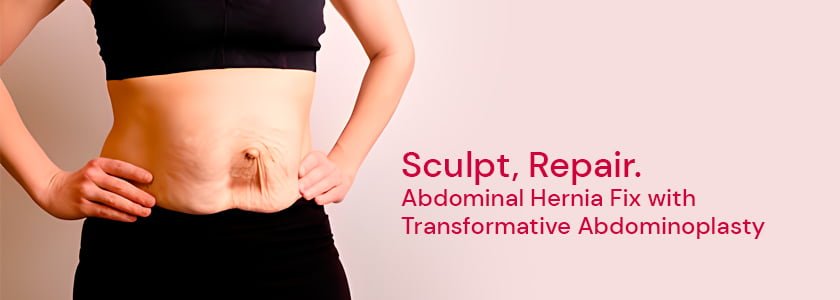Abdominal Wall Hernia Repair with Abdominoplasty

Even though ventral hernia surgery and abdominoplasty are two distinct operations, performing it together is usually a safe and practical combination, 95% of patients are interested in combining both.
Indications
1. Women who have had one or more children will have stretch marks and the abdominal wall musculature permanently weak by carrying a baby.
2. Following massive weight loss, the patient develops folds of overhanging skin
In either case, abdominoplasty is required to correct the unsightly tissue and skin.


Ventral hernia is a defect in the abdominal wall where intestine or abdominal tissue pushes through the defect.
There are several potential causes including
1. Birth defect and genetic weakness of the abdominal wall
2. Weakness caused by abdominal surgery such as appendicectomy and C-section
Ventral hernias are also called >incisional hernias because their origin is related to incisions of previous surgery, in 30% of patients.
Abdominoplasty
Abdominoplasty is mainly reshaping of the skin, muscle and fatty tissue of the abdomen, usually by removing skin and fatty tissue. This is purely cosmetic surgery, even when combining it with hernia repair.
The common name for abdominoplasty is “Tummy tuck”, requiring 1 to 5 hours under general anesthesia.
Complete Or Partial Abdominoplasty
In a complete abdominoplasty, the surgeon usually makes an incision to free the navel area from the surrounding skin. With partial abdominoplasty, the initial incision is smaller and the amount of tightening and fat removal is less. Very often excess fat is removed by liposuction. Finally, the skin is cut to fit the new shape of the abdomen and the ends of the skin sutured together. The final suturing of skin is a delicate work, like an art form, as the difference can be highly visible. The permanent suture line becomes almost invisible over a year or two. However, the position of the abdominoplasty incision, just above the pelvis, is usually not visible. Recovery from abdominoplasty is similar to that of any abdominal surgery. Heavy lifting or strenuous activity, including most sports, is not recommended for weeks after the surgery.
Umbilical hernias may develop or grow larger during pregnancy
Coupled with the stretching of the abdomen, childbearing may produce an umbilical hernia, one that involves the umbilical cord. About 10% of women already have a mild form of umbilical hernia which can become stretched and pushed into a significant umbilical hernia during pregnancy. However, much more common are ventral hernias associated with C-section.
Massive Weight Loss
People undergo various approaches – diet, bariatric surgery, physical therapy – to lose a massive amount of weight as quickly as possible. Folds of skin and fat sagging are common. Many obese people are already candidates for abdominoplasty. The condition of obesity itself contributes to the possibility of a ventral hernia. Years of carrying extra forward weight in the abdominal area has a tendency to weaken muscles and the abdominal wall that eventually leads to ventral hernia. Some people only discover the hernia after they lose significant amounts of weight.
Result

